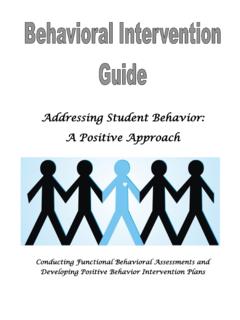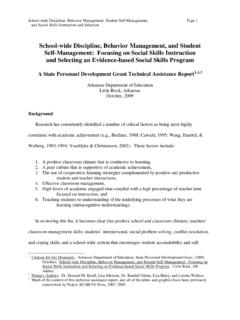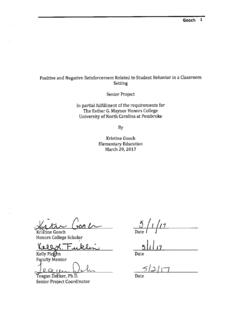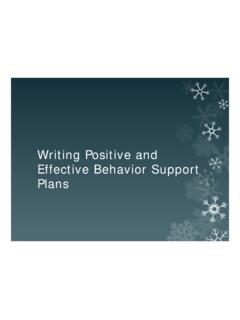Transcription of Addressing Student Behavior: A Positive Approach
1 Addressing Student behavior : A Positive Approach Conducting Functional behavioral Assessments and Developing Positive behavior Intervention Plans The purpose of the following information is to provide some ideas on interventions and strategies to include in the Positive behavior Intervention Plan (PBIP). This guide was written for the team to use when developing the PBIP. These strategies are not meant to be comprehensive or exclusive of other strategies/interventions. They simply represent a set of ideas that could be elaborated and modified for each individual Student s behavior . Remember, the interventions chosen for the PBIP should correspond with the function of behavior ( , if a Student s behavior is attention seeking, the team should choose interventions such as delivering attention only for appropriate behavior and withholding attention for inappropriate behavior ).
2 The contents of this guide include: Prevention Strategies Teaching Appropriate behavior Increasing Appropriate behavior (Reinforcement). Decreasing Inappropriate behavior Descriptions of behavioral Interventions (Alphabetical Order). Strategies for Effective behavior management o Do s and Don ts of behavior management o Common Problems and Helpful Hints o Delivering Effective Commands Note: Strategies with an asterisk (*) are described or defined in the Descriptions of behavioral Interventions section of this guide. behavioral Intervention Guide - 2 - AVOID CERTAIN TRIGGERS. Avoid large or noisy crowds Avoid long delays Avoid repetitive tasks ( , writing out spelling tasks).
3 Avoid power struggles*. Avoid long periods of desk work Avoid seating arrangements next to instigating peers Avoid negative language, such as no or stop . Avoid reprimands Avoid talking about the Student s problem behavior in their presence MODIFY CURRICULUM AND INSTRUCTION. Curriculum Adjustments*. o Appropriate and motivating curriculum*. o Adjust the amount of assignment given to the Student at once o Adjust the difficulty of the assignment o Intersperse difficult assignments with easier assignments o Break assignments into manageable sections*. o Modify task length*. o Assign tasks that require active participation o Assistive technology devices or services*.
4 O Allow for do-overs *. o Personal interests used for motivation*. o Provide extra time to complete assignments Instructional Adjustments o Shorten the instructional lesson o Instructional Pacing*. o Change voice intonation o Peer assisted instruction o Direct instruction o Increased academic learning time*. o Student follow-up*. o Student maintains a planner for assignments o Specific, or modified, instructions*. o Limited number of instructions provided at once o Multiple modes of instruction (visual, auditory, hands-on). o Increase reinforcement quality of classroom*. o Increase frequency of task related recognition*.
5 behavioral Intervention Guide - 3 - ENVIRONMENTAL ENGINEERING*. Post all classroom rules and daily schedules in prominent locations*. Preferential Seating *. Needed materials are easily accessible Rearrange the room or furniture Create separate or designated work areas Quiet areas*. Change the lighting Adjust sounds ( , volume of music, voice volume). Minimize or eliminate distracting materials*. Play music*. PROVIDE STRUCTURE. Set clear expectations and rules*. Preview rules and behavioral expectations*. Structured daily schedule*. Visual schedule*. Preview schedule*. Preferred activities scheduled in daily routines Schedule adjustment*.
6 Non-preferred activities scheduled among preferred activities Student involved in planning Planned activities for transition times*. Routines or signals to prepare for transitions Minimize down times*. Predictability*. Structuring non-instructional periods, including recess behavioral Intervention Guide - 4 - PROVIDE STRATEGIES TO INCREASE COMPLIANCE. behavioral momentum*. Offer choices*. 5-10 second compliance time window*. Effective commands*. Prompting*. Precision requests*. Proximity control*. Quiet start requests*. Allow flexible seating positions ( , stand, sit on knees). Systematic prompting (if age-appropriate)*.
7 DESIGN SOCIAL SUPPORTS. Positive peer role models*. High rates of Positive responses*. Peer mentor/tutor opportunity*. Peer involvement and influence*. Progress Reports*. Parent-Teacher Communication System*. Monitoring *. Personal Connection with Student *. Participation in extracurricular activities*. Positive peer reporting*. Transition supports*. Meaningful work projects*. PROMOTE SELF-REGULATION. Allow the Student to take frequent breaks during difficult work activities Provide time alone or time to regroup after a negative event Self-monitoring*. behavioral Intervention Guide - 5 - REPLACEMENT BEHAVIORS. These are communicative alternatives that provide an immediate mechanism for the Student to meet their needs.
8 The important part of this intervention is that the team must know the function of the behavior in order to teach an effective replacement skill. Functional Communication Skills*. [Verbal & non-verbal (cues, signs, picture cards)]. o Asking for attention o Raising hand o Asking for help o Requesting an item or activity o Asking questions o Seeking peer help o Requesting a break o Request to leave a situation ( , I want to be by myself for awhile ). o Requesting an alternative activity o Appropriately communicating a protest response o Negotiating a start time for a task o Alternative behaviors for sensory feedback*.
9 O Requesting movement ( , stretch break, squeeze stress ball, move to an empty desk, stand while working, sit on an exercise ball, go for a walk, etc.). Social Skills*. o Appropriate rejection/Ignoring*. o Appropriately initiating social interactions ( , Play with me ). o Socially appropriate play behaviors Suggesting an activity Sharing Waiting for a turn Incompatible behavior *. o Teaching a Student to sit in a chair instead of lie on the floor. o Giving a Student something to hold or do with his hands to avoid self-injury or other disruptive behavior o Sitting with hands folded in lap instead of poking or pinching peers Identify appropriate settings for the behavior *.
10 behavioral Intervention Guide - 6 - OTHER ALTERNATIVE BEHAVIORS. These are skills that teach the Student to cope with or tolerate difficult situations. They also alter problem situations and prevent the need for problem behaviors. Organizational skills to reduce frustration Social skills to increase appropriate peer interactions*. Problem Solving skills*. o Conflict resolution o Choice making Tolerance skills*. o Longer wait times for teacher attention o Ignoring instigating peers o Delays to get the reinforcer ( , waiting for an activity)*. o Appropriately dealing with peer accusations o Walking away from fights o Accepting no.










